Country Profile
Sweden is a country covering the east side of Scandinavian Peninsula and stretches narrowly north from south, and seventh part of its national territory lies within the Arctic Circle. Most of the country is woodland that lies mainly above Central Sweden. South Sweden is the fertile plain. Greater part of the national territory belongs to cool-temperate climate though it turns to temperate zone down at the south due to the North Atlantic Current where the climate is relatively warm despite its high latitude. Winter cold is severe under the climate of Siberia. The high latitude brings a long daylight time in summer while the country experiences a long nighttime in winter.
FigureMap of Sweden
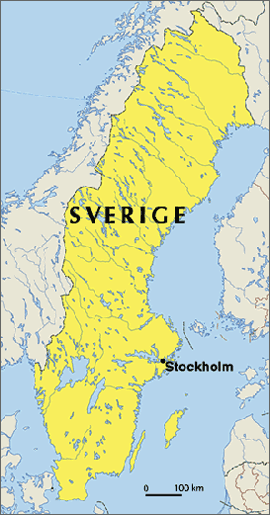
Source: http://europa.eu/about-eu/countries/member-countries/sweden/index_en.htm
Population of Sweden is approximately 9.6 million (2013) of which 90 % lives at the south half of national territory. Moreover, approx. 40% of the population lives in the three metropolitan areas (approx. 2.1 million in Stockholm metropolitan area, a million at Göteborg metropolitan area and 0.7 million in Malmö metropolitan area).
Population of Sweden grew rapidly after the Second World War and currently in 2011 approx. 20% of the population are immigrants, either foreign born or having parents/parent from foreign country/countries.
Sweden joined EU in 1995 but has not adopted Europe's unified currency.
TableSweden fast facts
| Country name | Kingdom of Sweden |
|---|---|
| Surface area | Approx. 450,000 km² (About 1.2 times of that of Japan) |
| Population | Approx. 9.88 million |
| Population density | 22/km² |
| Percentage of urban population | 85.8% (2015) |
| GDP | USD 492.6 billion (2015: IMF) |
| GDP per capita | USD 49,866 (2015: IMF) |
| Percentage of employment by industry | agriculture: 1.7% industry: 34.2% services: 64% (2016 est.) |
| Economic growth rate | 4.1% (2015: IMF) |
(Information Updated: March 2017)
Administrative system of Sweden
Government of Sweden is composed of prime minister and other cabinet ministers, and there is Government Offices, an integral authority, to assist the activities of the government and ministers. Government Offices consists of Prime Minister's Office, Ministries (there are currently 11 Ministries) and Office of Administrative Affairs. Each ministry deals with basic issues (basic principle, budget, law, etc.,) for the policies related to their responsible fields and the number of staff is around a few hundred each which is relatively small. At the same time, there are about 360 government agencies handling actual administrative work with more number of staff.
Self-governing local authorities of Sweden consist of 20 county councils (Landsting)* and 290 municipalities (Kommuner).
Municipality covers a broad range of work fields from the weighted fields of education and welfare through to employment, infrastructure development and culture. County council is the self-governing local authority for wider area including more than one municipality but its field of work is less than that of municipality and is mostly specialized in medical affairs. Municipalities and county councils stand as equals sharing administrative works by their covering space and population, and that means county council is not an upper-level authority of municipality.
For each county (Län), which is the administrative district of each county council, there is a county administrative board (Länsstyrelsen) as the representative of central government.** County administrative board takes charge of national administrative work within the county, and has a responsibility to coordinate activities within the central government, municipalities and county council from the view of comprehensive goals of environmental and regional policy.
- *County councils include Regions (Regioner) which were experimentally introduced in 1997 to replace county councils and later became fixed in 2009 (there are 4 Regions at the moment -- Region Skåne, Västra Götalandsregionen (Region Västra Götaland), Region Halland and Region Gotland -- with the exception of Region Gotland which is counted as a municipality). In addition to the traditional tasks and duties of the county councils, Regions also have responsibility for regional development (including drawing up strategies for the region's development, deciding on investments in regional transportation infrastructure, and distributing funds for development initiatives).
- **As for Gotland municipality whose administrative district (consisting of Gotland Island, the largest island of Sweden, and surrounding islands) corresponds that of Gotland county, the municipality serves as a county council as well. There is a county administrative board too for the county, which means the total number of county administrative boards is 21, one more than the number of county councils. Furthermore, Gotland municipality changed its name to Region Gotland in 2011.
Figure:Administrative System of Sweden
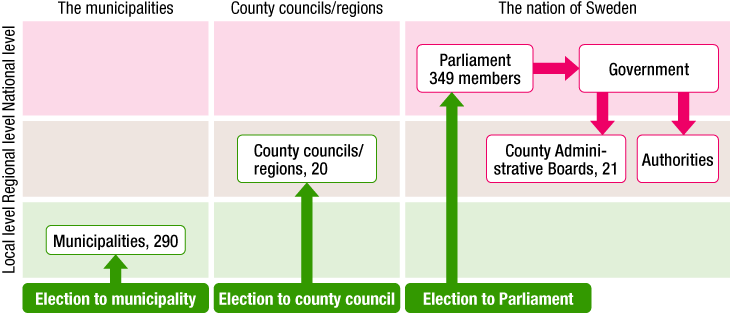
Source: Ministry of Swedish Association of Local Authorities and Regions
Regulatory power for land use and construction is at the municipality as stated in Planning and Building Act. There are only five grounds for the central government's intervention (to be described later), and the intervention could take place through county administrative board. The Planning and Building Act allows formulating regional plans for use in the case of planning issues that concern several municipalities. In reality, however, such regional plans only exist in Stockholm region and Göteborg region.
On the other hand, Ordinance 2003:595 on Regional Development Work, apart from planning and building system, requires authorities dealing with coordination of regional development in all 21 counties (which means county councils, regional municipal cooperation bodies or county administrative boards) to establish Regional Development Programme (RUP). At the same time, the Swedish government formulated National Strategy for Regional Competitiveness, Entrepreneurship and Employment 2007-2013 as an instrument to help to develop strategic focuses in each region's Programme. Formulation of the national strategy was also to meet the EU's request for each member country to prepare National Strategic Reference Framework (NSRF) according to EU cohesion policy (regional policy). To satisfy the function of NSRF, the strategy sets out Regional Structural Fund Programmes for Regional Competitiveness and Employment 2007-2013 which divides the whole country into eight parts according to the distribution unit of European Regional Development Fund (ERDF).
Figure:Planning System of Sweden
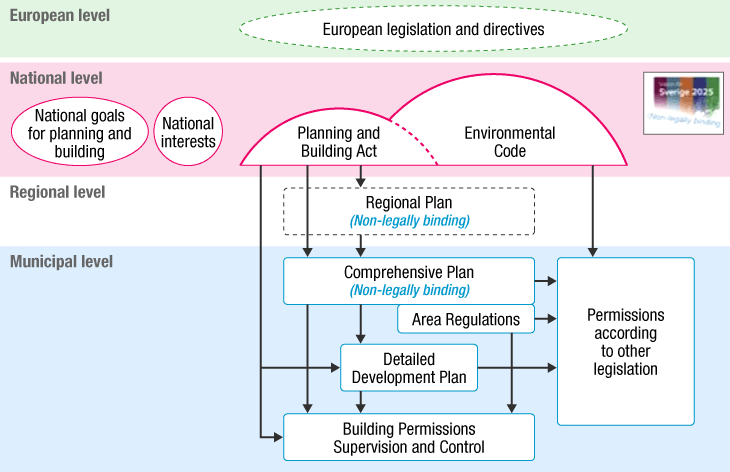
Source: Swedish National Board of Housing, Building and Planning
Figure:Main Strategy and Instrument of Regional Growth Policy
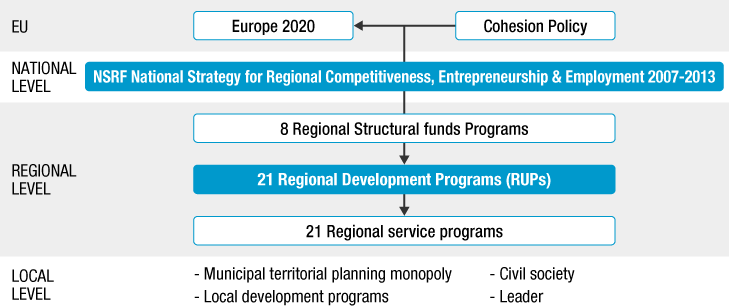
Source: Ministry of Enterprise, Energy and Communications
Major Authorities Relating to Territorial and Regional Policies
| Administrative area | Authority | Web site |
|---|---|---|
| Physical Plan (Urban/Regional Plan) |
Ministry of Health and Social Affairs | http://www.government.se/sb/d/2061 |
| Swedish National Board of Housing, Building and Planning | http://www.boverket.se/en/start-in-english/ | |
| Regional Growth (Development) Policy | Ministry of Enterprise and Innovation | http://www.government.se/sb/d/2067 |
| Swedish Agency for Economic and Regional Growth | https://tillvaxtverket.se/english.html |
Physical Planning (Land Use Planning)
Physical planning in Sweden is controlled under the strong authority of municipality which is even being explained as "municipal planning monopoly". The nation could intervene with municipal planning at very limited cases such as when national interests are being harmed. This tradition of "municipal planning monopoly" began in 1907 when Town Planning Act was enacted and it has been continuing until today, though there had been a few system changes in the balance of power between the nation and municipality. Introduction of the viewpoint of national interest represents such system changes and it was the fruition of the concept of national physical planning which had been discussed since 1965 to deal with rapid economic growth and industrial expansion in the 1960s. Controversy over this concept ended with the enactment of Natural Resources Act in 1987, which had first given the definition of national interests, and Swedish Environmental Code (1998:808), which had expansively embraced the Natural Resources Act.
"National interests" describe geographic area that are of national importance for: different social interests such as ecology, heritage, recreation; or particular industries such as agriculture, forestry, fishery, or reindeer husbandry. It may include areas for future infrastructure developments such as roads, railways, or power plants. National interests are described by responsible national authorities according to their policy fields.
The main rule is that a proposed land use change cannot be approved if it would involve substantial injury to a national interest. The meaning and definite demarcation of the national interest areas are defined by municipalities in comprehensive plans, in agreement with county administrative board. Herein, county administrative board has overall responsibility for national interests and is required to coordinate governmental interests and provide information about them to municipalities in work on the formulation of their comprehensive plans.
Elements other than national interests that restrict municipal planning are environmental quality standards and shore protection legislation. Environmental quality standards stipulate air quality, water quality and environmental noise, most of which are based on EU requirements. Shore protection legislation was established in the 1950s to prevent the overexploitation of shores and to preserve public access to shores and water recreation, which was expanded in 1994 to include biodiversity. The protection applies to land and water areas that are within 100 meters from shoreline (there are cases where the buffer is extended to 300 meters), and new construction or use change of buildings in the protected zone is not allowed, although there are some cases municipalities set exemption area based on their comprehensive plans.
The only grounds the nation could intervene with municipal planning (comprehensive plan, detailed plan and area regulations) through county administrative board are: (1) a national interest is not considered; (2) inter-municipal planning issues have not been coordinated; (3) an environmental quality standard is not followed; (4) the protection of shores is lifted but is conflicting; and (5) the regulations or planned buildings are unsuitable to health, security, disaster, flooding or erosion risks.
Meanwhile, there are two regions having regional plans as physical plans based on Planning and Building Act: Stockholm region (area equivalent to Stockholm County), and Göteborg region (a part of Västra Götalands County). However regional planning body differs in each case: county council for the former, association of municipalities for the latter. Regional planning body which Planning and Building Act stipulates is the association of municipalities, which means the regional plan of Stockholm region does not fit the rule. This is because special law for Stockholm County (Act (1987:147) on Regional Planning for Municipalities in Stockholm County) has given authority to Stockholm County Council to formulate regional plan.
Regional Development Policy (National and Regional levels)
- National Level
- National Strategy for Regional Competitiveness, Entrepreneurship and Employment 2007-2013 formulated by Ministry of Enterprise, Energy and Communications is the policy paper which serves as the implementation framework of European Regional Development Fund Programme for Sweden (applied for each of eight blocs created throughout the country) and National Structural Fund Programme (accompanied by regional plans for the eight blocs conforming the EU Programme) granted from governmental fund. This national strategy, through showing national priorities for regional development, aims at providing guidance for regional development work at national/regional/municipal levels. The identified national priorities are: innovation and renewal; skills supply and improved workforce supply; accessibility and strategic cross-border cooperation.
- Regional Level
- Based on Ordinance on Regional Development Work, every county must formulate Regional Development Programme (RUP). This Programme is prepared by county administrative board through discussions with county council, municipalities, enterprises and organizations in the county and related government agencies, which means that the responsibility of formulation is basically at county administrative board. However, the responsibility can be transferred to association of municipalities, and today only four county administrative boards keep the responsibility. Moreover, there are four counties whose association of municipalities transferred the responsibility to county council (or Region) and still there are more counties applying for the same pattern of transfer.
- Recent regional plan of Stockholm region (RUFS2010) is called "Regional Development Plan", and has a formal status as regional plan according to Planning and Building Act as well as regional development programme (RUP) according to the Ordinance on Regional Development Work. Such movement towards establishing a plan having the two roles is ongoing at multiple regions, for example, Skåne region (one of the top three urban regions along with Stockholm region and Göteborg region).
- As such, there are a variety of trends related to regional planning and regional development in Sweden, and that is even described: "There is obviously no single Swedish model for regional planning or regional development." (Jhonson G (2013) 'Regional Planning in Sweden', in Lundstrom M S, C Fredriksson and J Witzell (eds) Planning and Sustaibable Urban Development in Sweden)
Regional Plan - Stockholm Region
There are 26 municipalities in the Stockholm region (county) with a total population of more than two million inhabitants. For the region, regional plans were formulated for six times (1958, 1973, 1978, 1991, 2001 and 2010).
Targeted years of RUFS 2010 are; (1) 2050 (targeted year of spatial structural formulation of East-Central Sweden); (2) 2030 (formal targeted year of the plan and also the year relating with planning period of each municipality's comprehensive plan) ; and (3) 2020 (the year relating to the national planning of investments in infrastructure and Structural Fund Programme).
RUFS 2010 is characterized by an overall approach integrating issues of economic development and physical development. It aims at: sustainable development including economic, ecological, social and cultural aspects; and increase of regional growth focusing on accessibility and innovative environment.
It is worth mentioning that in reaction to the fact that commuting area of Stockholm has been spreading out of Stockholm County, the plan has put more focus on overall East-Central Sweden (consisting of 7 counties) compared to former plans. Recently the population of East-Central Sweden is about 3.5 million.
Despite showing increased concern for East-Central Sweden, the plan primarily deals with the situation in the Stockholm County. It aims at guiding the locations of new housing development for expected population growth of 300-500 thousand to the areas close to existing urban areas, and producing dense urban environment that are accessible by public transport. It emphasizes to provide sufficient public transport from the view of enhancing international competitiveness of the region, strengthening linkages within East-Central Sweden, and reducing environment impact of the transport sector. At the same time, it aims to establish 8 additional cores in addition to the central core of Stockholm as growth centers for dynamic and attractive regional development.
Figure:Development Prospect of East-Central Sweden in 2050 and Urban Cores within Stockholm County (upper right)
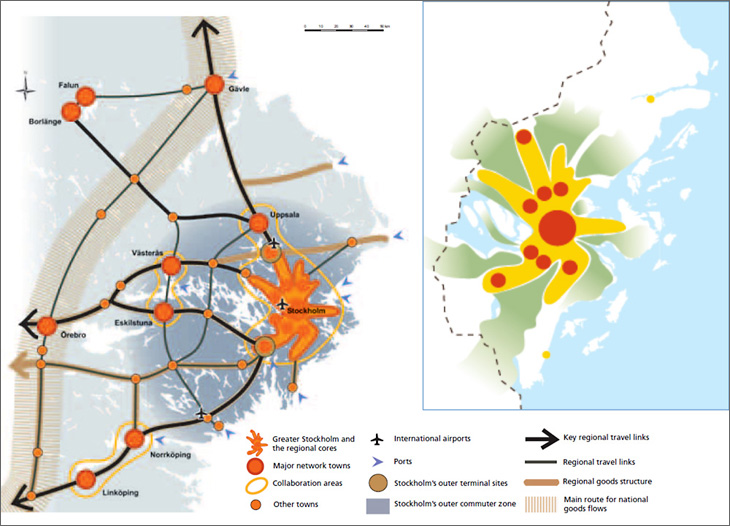
Source: Stockhokm County Council (2010) "RUFS 2010"
Reform of Administrative System at Regional Level
It has long been discussed in Sweden about the ideal wide-area administrative system. For instance, should the role of county council be integrated into that of county administrative board or the board be merged into the council. An experiment began in 1997 in Skåne and Västra Götalands to transfer some responsibilities of county administrative board to county council, resulting in the establishment of Region Skåne (by merging former two county councils) and Västra Götalandsregionen (by merging three county councils) and the transfer of regional development work to the Regions. Thereafter, Halland and Gotland became Regions, and responsibility on regional development was transferred as well. (The four regions are colored purple in the left map of the figure below.)
Today there are many counties whose responsibility of regional development is not held by Region but by regional municipal cooperation body (colored yellow in the left map of the figure below). On the other hand, there are only four counties, including Stockholm, where regional development is dealt by county administrative board, the outreach authority of the nation which is not directly related to electorate (colored blue in the left map of the figure below)
Figure:Regional Classification by the Bearer of Responsibility in Regional Development
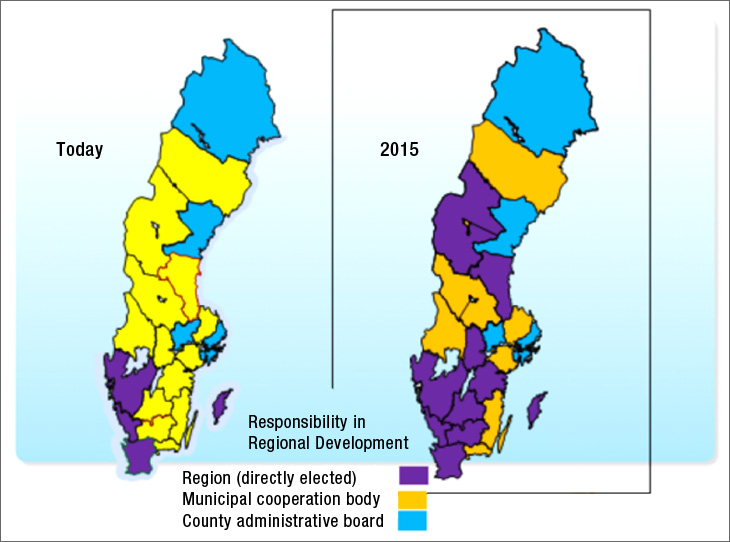
Source: Swedish Association of Local Administration and Regions
The central government does not take initiative at all in the occasion of merger of county councils or transformation to Regions. It will be decided through bottom-up process according to the proposal from each region. From 2015 and onward more transformation from county council to Region is expected to proceed (see the changes of purple-colored parts in the figure above).
At least for a while no merger of county councils is being planned but there are some being under consideration, which means there is a possibility of decreasing of county councils after 2018.
Dealing with Regional Development of Rural and Sparsely Populated Areas
Figure:Sparsely populated and Rural areas in Sweden (according to National Rural Development Agency definition)
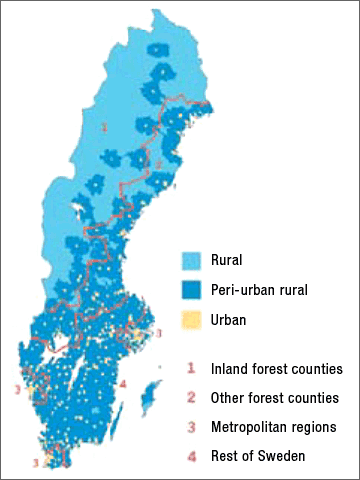
Source: Government offices of Sweden (2008) Rural Development Program for Sweden
Sparsely populated areas spread across the inland area of Norrland (9 counties at the north) and west of Svealand (6 counties at the central Sweden), and population of these areas is less than 500 thousand. Except from this, about 30 thousand live in similar disadvantaged areas such as isolated islands. Most of these areas are experiencing population decrease.
With the recognition that expanding regional disparity is a current issue, National Strategy for Regional Competitiveness, Entrepreneurship and Employment 2007-2013 stated, in addition to the three emphasized fields (cited before), the government's intention to promote development with consideration of the specific condition of northern Sweden. On the other hand, this strategic paper expresses that strategies based on rural-specific conditions related to economic, social and environmental development should be dealt by Rural Development Programme (2007-2013).
In dealing with regional development, National Strategy for Regional Competitiveness, Entrepreneurship and Employment 2007-2013 describes the necessity of:, among others: (1) strengthening linkage between urban area and sparsely populated / rural area; (2) promoting tourism and tourism-related industry (such as experience industry); (3) continuing development in broadband and internet environment; (4) strengthening cooperation with EU cohesion policy (including EU's special aid for sparsely populated areas in Nordic countries); (5) enhancing more opportunities to develop regional basic industries (including those related to science technology and service development); (6) promoting further cooperation within public sector, colleges and local industry towards regional development.
Rural Development Programme for Sweden the Period 2007-2013 includes initiatives for regional development (e.g., concerning competitiveness, entrepreneurship, growth, technical innovation of agriculture and forestry enterprises, food industry and small business in rural areas). The aim of the initiatives is to enhance competitiveness of rural industry as well as to accelerate creation of regional income and employment opportunity by promoting industrial variability in rural areas. It is also intended to contribute to sustainable use of natural resources in rural areas. At the same time it seeks to operate closely with EU agricultural policies such as Leader+ Community Initiative.
Targets of Rural Development Programme encompass: local initiatives targeted at archipelagos and islands; and development of Sami region (settlement area of Sami, indigenous people of Scandinavia) including reindeer herding industry promotion. As for Sami region, in order to ensure that due consideration is given to Sami issues, the Sami parliament (a publically-elected parliament with the status of government agency) is responsible for drawing up a strategy for the implementation of measures in the Rural Development Programme, while this role is undertaken by county councils in other areas.
(Information Updated: March 2014)
